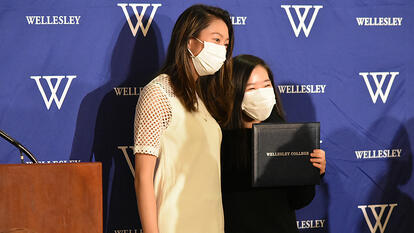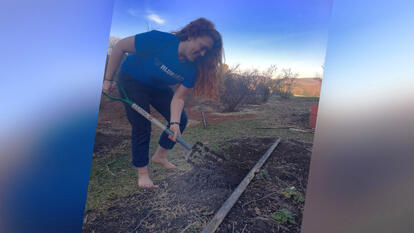
Trash Talk: How ES 300 tackled Wellesley’s waste problem
ES 300: Environmental Decision-Making is a class without a set curriculum. Every year the ES 300 students have worked together on a different capstone project that analyzes some aspect of Wellesley’s ecological footprint. Beth DeSombre, Camilla Chandler Frost Professor of Environmental Studies, created the course in 2003, and classes have looked at the College’s greenhouse gas emissions, how to sustainably renovate the athletics complex, and the potential benefits of building a farm on campus. The idea for this past year’s capstone came after DeSombre served on the Academic Council’s Sustainability Committee with Dave Chakraborty, assistant vice president of facilities management and planning. DeSombre and Chakraborty thought that ES 300’s next project should be looking at the College’s current recycling rate and how it can reduce waste output.
Chakraborty suspected Wellesley’s waste management problem had worsened throughout COVID, and he thought ES 300 could figure out if his suspicions were true. “I posed three questions to the class,” says Chakraboty. “Why is Wellesley’s recycling rate so poor? Our rate is in the low-to-mid 20% while our peer institutions are at 50%. What’s the reason for that? What should be our target recycling rate? And how do we get there?”
The 16 students in ES 300 got to work. “We basically get to turn ourselves into an environmental consulting firm for the College,” says Andreea Sabau ’23, an environmental studies and political science double major who took the class this spring.
They applied for specific roles and were divided into four teams to tackle the substantial project. Abigail George ’23 became the project manager, overseeing the goals and deadlines, planning weekly meetings, setting the agenda, and checking in with the other group leaders. “I was the catch-all person,” says George. Bianca Lee ’24 was the media point-person, and Sabau served as the overall text editor for the final report, Let’s Talk About Waste, Baby: Systems to Use Less and Divert More.
I admire the class for the quality of the report and how seriously they talk about this problem and come up with answers. I’m thankful for the work they’ve done.
Dave Chakraborty, assistant vice president of facilities management and planning
Luka Pearson ’23, an environmental studies major and computer science minor, was the data editor. “I was really grateful for the chance to assume a leadership position and to have an integral role in organizing information and communicating with people,” they say. Pearson says presenting in front of the class and leading discussions was challenging, but enjoyable: “I feel more confident tackling it in the future.”
The ES 300 students collaborated with the facilities staff to gather information that had previously been decentralized and compiled it so that they could see all of the College’s waste output in one place. They also donned hazmat suits and conducted a trash audit on March 6, going through one week’s worth of waste the facilities team had set aside from Bates Dining Hall, the McAfee-Bates-Freeman dorm complex, and Green Hall, to represent waste generated by dining, residential, and academic operations. They used the trash audit numbers to estimate the total amount of waste produced by the College annually.
The resulting 346-page report covered Wellesley’s history of waste management, the methodology students used in the current project, their goals for the project and the College, the criteria they used for data analysis, and their proposed waste reduction options.
“They did a very thorough job of analyzing the problem and finding areas of improvement,” says Chakraborty. “I admire the class for the quality of the report and how seriously they talk about this problem and come up with answers. I’m thankful for the work they’ve done.”
The ES 300 students estimated that the College produces 970 tons of trash annually. Of that, 50% comes from the residential sector, 17% from the dining halls, and 33% from academic buildings. They project that 47% of the waste could be diverted from the trash stream by being recycled or composted.
“All of us were shocked by the waste audit experience,” says Lee. “We were all just amazed by how many things are being thrown out that don’t have to be thrown out.” Students were particularly alarmed by the amount of food waste. George says the Wellesley community needs to be aware of the College’s waste situation, but also that the problem is systemic; it’s not just the fault of some people who throw out things that could be recycled or composted. DeSombre agrees: “We need to be thinking about systems rather than haranguing individuals. People’s waste behavior is embedded in structures, so we have to find ways to make it easier to do the right thing.” For example, the College could add more compost bins, hire more people in the Office of Sustainability, and possibly employ student workers to monitor trash, compost, and recycling.
“Wellesley has problems, but they are solvable,” says George. ES 300 students recommended six actions the College could take to reduce waste:
-
Retrain dining hall workers to divert all pre-consumer dining hall waste to the organic waste stream.
-
Ban single-use products in dining halls.
-
Expand the OZZI box reusable container program.
-
Implement comprehensive, continuous waste education programs.
-
Add more compost bins across campus.
-
Enforce a zero-waste requirement on large events, with the end goal of establishing infrastructure to make it accessible for all events to be zero waste.
If the College administration and members of the Wellesley community are able to take some or all of these measures, students feel hopeful about lowering Wellesley's waste output. Pearson was happy to see how many students attended the class’s Ruhlman Conference presentation this spring. “There was a lot of student interest in what we are doing, and it was really encouraging to see there are students who want to carry this forward,” says Pearson.
“It is great to work with our students in addressing these issues,” says Chakraborty. “They get the experience of doing the research, writing the report, and coming up with the ideas themselves, and because their recommendations are rooted in their experiences at Wellesley, there is a greater likelihood their ideas will lead to lasting improvement.”



